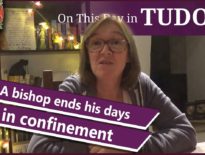On this day in Tudor history, 19th November 1564, Lord John Grey, youngest son of Thomas Grey, 2nd Marquess of Dorset, died.
He's not the Lord John Grey of the wonderful Outlander series, but he is just as interesting.
In Mary I's reign, he was involved in a rebellion with his brothers, Lord Thomas Grey and Henry Grey, Duke of Suffolk, but unlike them was not executed.
How did Lord John Grey escape execution? And why did he get into trouble again in Elizabeth I's reign.
Find out all about this Tudor lord in today's talk.
Also on this day in Tudor history, 19th November 1587, Henry Vaux died of what was probably consumption at Great Ashby, the home of his sister, Eleanor Brooksby.
Henry Vaux is a fascinating Tudor man. He started out as a precocious child and poet, and grew up to be an important member of the Catholic underground. He was a Catholic recusant and priest harbourer, helping Jesuit priests in the Protestant reign of Queen Elizabeth I, both financially and by giving them a roof over the heads. Find out more about him, and what happened to him in Queen Elizabeth I's reign, in last year’s video:
Also on this day in history:
- 1563 - Robert Sidney, 1st Earl of Leicester, courtier, patron of the arts and poet, was born at Penshurst in Kent. It was discovered that Robert was a poet, like his more famous brother Philip, when his notebook came to light in the library of Warwick Castle in the 1960s. The notebook contained a collection of over sixty sonnets, pastorals, songs and shorter pieces written in the 1590s. It can now be found in the British Library.
- 1566 – Death of Reynold Corbet, member of Parliament and judge. He was buried at Stoke upon Tern in Shropshire. Corbet's offices included recorder of Shrewsbury, Justice of the Peace for Shropshire, a member of the Council in the Marches and Puisne Justice of the Queen's Bench.
- 1584 – Death of William Bendlowes, member of Parliament, Serjeant-at-Law and Law Reporter. He was buried at Great Bardfield in Essex, where his monumental brass can still be seen today. Bendlowes reported on court cases from the period 1534-1579.
- 1590 – Death of Thomas Godwin, physician and Bishop of Bath and Wells, at Wokingham in Berkshire, his birthplace. He had retired there due to ill health, and was buried in the local church. Elizabeth I chose Godwin as one of her Lent preachers, and he served in that post for eighteen years.
- 1604 – Death of Richard Edes, Dean of Worcester, royal chaplain and court preacher, at Worcester. He was buried in Worcester Cathedral. Edes was a royal chaplain to Elizabeth I and James I, and had just been appointed to work on a new version of the English Bible when he died.
Transcript:
On this day in Tudor history, 19th November 1564, Lord John Grey, youngest son of Thomas Grey, 2nd Marquess of Dorset, died.
Ok, so he’s not the Lord John Grey of Outlander, but he did have quite an exciting life, managing to avoid the fate of his brother, Henry Grey, Duke of Suffolk, father of Lady Jane Grey, who was executed for his involvement in Wyatt’s Rebellion even though he was also involved.
Let me tell you a bit more about this Lord John and how he escaped the axeman in 1554…
• John was born in around 1523/4 and was the youngest son of Thomas Grey, 2nd Marquess of Dorset, and his second wife, Margaret Wotton. His paternal great-grandparents were Sir John Grey of Groby and Elizabeth Woodville.
• In Edward VI’s reign, John was appointed Lord Deputy of Newhaven, as well as being granted estates in Leicestershire, Derbyshire and Nottinghamshire.
• At some point, John married Mary Browne, daughter of Sir Anthony Browne, who had served Henry VIII as his Master of the Horse. John and Mary had seven children, three sons and four daughters.
• Following the Catholic Mary I’s accession to the throne, John became involved in the 1554 Wyatt’s Rebellion which was led by Sir Thomas Wyatt the Younger and which sought to depose Mary and replace her with her half-sister Elizabeth. John’s fellow conspirators included his older brothers Henry Grey, Duke of Suffolk, and Lord Thomas Grey. The rebellion failed after Mary rallied the citizens of London against the rebels, and the Grey brothers were arrested. John was arrested at Astley in Warwickshire on 2nd February 1554, with his brother Suffolk.
• John’s brothers, Henry and Thomas were both executed as traitors, in February and April respectively, and John was tried in May 1554. He was found guilty and condemned to death on 11th June 1554.
• John was saved from execution by the intercession of his wife Mary, whose brother was the Catholic Viscount Montagu, a man close to Queen Mary. John was released in October 1554 and pardoned on 17th January 1554. Sensibly, he chose a quiet life away from court for the rest of Mary’s reign.
• He returned to court on the accession of the Protestant Queen Elizabeth I in late 1558, serving her on her first progress. At New Year 1559, he gave the queen a mother-of-pearl cup.
• Although he’d been pardoned, Lord John was still under attainder and so was suffering financially. After he pleaded poverty to William Cecil, Baron Burghley, he was granted the Essex Manor of Pyrgo in April 1559, as well as further lands in Somerset. The new queen also released him from the attainder and restored him in blood. Burghley chose John as one of four Protestant nobles to supervise alterations being made to the Book of Common Prayer.
• In 1563, John’s niece, Lady Katherine Grey, sister of Lady Jane Grey, was moved to Pyrgo under John’s care. She’d just been released from the Tower of London into house arrest. Katherine had of course got into trouble with the queen after her secret marriage to Edward Seymour, Earl of Hertford, in 1560. She’d managed to have two sons by him during her imprisonment.
John interceded on his niece’s behalf, writing to Burghley pleading for a pardon, but unfortunately, in 1564 a man called John Hales wrote and published a book claiming that Katherine was Elizabeth’s heir. The queen reacted by removing Katherine from Pyrgo and imprisoning John temporarily. Katherine was imprisoned in the Tower once more.
• John returned to Pyrgo on his release and died there on this day in 1564, reportedly from gout. He was laid to rest in the manor’s chapel. He left everything to his wife Mary, who he’d also named his executor. His only surviving son, Henry, was made Baron Grey of Groby in July 1603 after the accession of James I.
• John’s great-great-grandson was Thomas Grey, Lord Grey of Groby, who committed regicide by being one of the 59 commissioners to sign King Charles I’s death warrant in 1649.



Leave a Reply